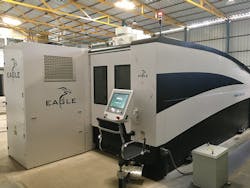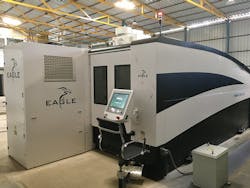Perspective from a leading laser equipment supplier
RAKESH AGARWAL
India has a 5% share of the more than $12 billion global laser market. With a compound annual growth rate (CAGR) of 11.6%, the global laser market is expected to cross $21 billion in the next five years and India will be main contributor to this growth (SIDEBAR, below). After 2012, the Indian laser cutting market grew tenfold, from 50 units per year to 500 units per year.
Editor's Note: Anant Deshpande, Industrial Laser Solutions Editorial Advisor for India and a contemporary of Rakesh Agarwal, offers these additional comments on the market for industrial lasers in this country.
With prices for fiber laser cutting machines decreasing almost day by day, the market—which previously was focused on job shops—now includes companies making the products to have such machines in-house. The cost of the earlier machines was exorbitantly high and required trained manpower, so companies were outsourcing to job shops. However, with the drop in prices (a 1kW laser now costs under $50,000), these companies now have them in-house. This trend is growing, as the cost of machines is coming down-this is mainly responsible for the growth of the sheet metal cutting machine.
The market for lasers in India is driven by the automotive sector and, thus, job shops for sheet metal cutting. These are mainly located in automotive hubs such as Pune, Bangalore, Chennai, Manesar (near Delhi), and Ahmedabad, which together account for more than 80% of the job shop market for metal cutting lasers. While the machine tool industry is spread throughout India, it is more so in Punjab, Chandigar, Ludhina, and Coimbatore, while lasers for diamond processing are mainly focused in Surat, with more than 10,000 to 12,000 lasers used.
Sahajanand in Ahmedabad started the fiber laser cutting market in India. They were the first company to manufacture a fiber laser-based cutting system, having a patent on the fiber laser system design. There are other companies such as Scantech (Mumbai), Suresh Ind (Pune), Proteck (Chennai), A Innovative (Ahmedabad), Mehta CAD CAM (Ahmedabad), and Lastronix (Ahmedabad), to name a few, who are now making sheet metal cutting machines. Other companies act as distributors, selling these machines with names such as Angle CAD CAM (Delhi), Laser Technologies, (Mumbai), and Sigma Mechatronix, among others.
Major international players, with offices in India, have sold their complete systems in India for a long time, dominated by TRUMPF, Amada, Bystronic, LVD, Prima Power Laserdyne, Han's Laser, Golden Laser, and others. They were the dominant players for the metal cutting market until Chinese lasers started to capture the market with their low-cost metal cutting systems (mainly 500W).
With this growing market, the need for technical manpower is increasing. However, the lack of trained manpower is the reason that local manufacturers and distributors are not growing, as the dearth of manpower is not allowing them to expand beyond a point.
Other applications such as cladding, welding, and hardening are growing, but the growth rate for them is not as fast as cutting and marking. With cost coming down for lasers, however, there is a growing demand for these applications and, with the Make in India campaign, more and more companies are getting into systems and solutions done locally.
As a company that has seen the market evolve over the last decade, we believe that the demand for lasers is about to skyrocket in this country. The growth will be fueled by economical fiber laser cutting machines, the need for technology, the demise of used machines, and other laser applications.
Affordable machines
Girdhar Sharma, from the company Vibrotech in New Delhi, was a small-scale air handling equipment manufacturer. His 1–2mm sheet metal and fabrication requirements were cutting and bending—most of the cutting work was outsourced to a job shop located next to his factory, while bending and finishing was done in his own factory.
When the job-shop owners decided to shift their factory to a new location a few miles away, Sharma came face to face with a logistic nightmare, as the nearest job shop was at least 4.5 miles away. However, instead of looking for alternative job shops, he decided to purchase a laser cutting machine of his own (FIGURE 1).
The company's sales and service engineers have been witnessing similar scenarios more over the last few years. In the classic make-vs.-buy dilemma, "make" is clearly winning. So, why is this back-integration making more sense now than ever before? The answer is that demand has increased significantly and machines have become more affordable.
Despite being the poster child for a service-based growth model, India's trade deficit from importing goods is four times its trade surplus from exporting services. This has led to a paradigm shift, and growing the manufacturing sector has become the number-one agenda of the Indian government. Attractive schemes, like the much-advertised Make in India campaign, have been launched to galvanize the industry, resulting in 9.3% growth in the manufacturing sector over the last year.
Lasers have also become much more affordable, as machines now cost 25% of the price of similar machines a few years back. New government schemes also provide subsidies on investment, as well as interest subsidies and insurance. Sharma expects to recover his investment within a year—this is the reason that Laser Technologies sold over 50 economical fiber laser cutting machines last year.
Prioritizing laser efficiency
On the other end of the spectrum, Jayesh Ramani from Powerbeam Technology Mumbai owns India's first and fastest laser cutting machine—a 6kW system with an acceleration of 6G from Polish laser manufacturer Eagle (FIGURE 2), as his primary concern is efficiency rather than capital. Ramani, with seven different laser cutting machines, is an OEM for Siemens, L&T, and Godrej, and has a virtually unlimited demand for his job shop.
"Having one very efficient machine is much more profitable to us than several machines running in parallel. Most importantly, I am not worried about the production anymore and the machine makes my factory futuristic," Ramani explains. "Not only does it reduce the maintenance, it also saves me a lot of space," he says. This is a pertinent remark, as Mumbai remains one of the world's most expensive real estate markets. However, the most important observation is about quality, in terms of which machine adheres to market demand.
As more global companies set up their manufacturing plants in the country, quality norms will become more and more stringent and an increasing number of OEMs will subscribe to Ramani's views about possessing cutting-edge technology.
One sector that takes quality very seriously and happens to be the biggest consumer of laser-processed goods is the automotive sector, which is presently in overdrive—India is poised to become the fourth largest automotive market in the world in 2017. Companies like Kia and Kawasaki have already announced plans to set up manufacturing plants in India; Maruti, Honda, Toyota, and other big players are expanding their production capacity; and Toyota is targeting the export of left-hand-drive cars from India.
Second thoughts about seconds
In the 2000s, the Indian market was flooded with used CO2 laser cutting machines. Factories operating these high-maintenance secondhand machines are now at risk of becoming outdated in the market. All these machines have become obsolete and will need replacement.
While it is impossible to know the exact number of still-operational secondhand machines in the country, our data suggests that replacement of these machines will be responsible for almost 25% of total sales in the coming year.
Additional applications
The Indian market is slowly warming up to other applications of lasers such as welding, hardening, and cladding—for example, advances in automation, speed, and accuracy have made lasers very useful for the packaging industry. While lasers are already the first choice for flexible and innovative packaging, with a little more advancement, the technology is well poised to replace dies and molds as well.
Lasers provide more flexibility in packaging than the traditional hard-coded machines. With the packaging industry hinging on innovation more than ever, lasers have become the obvious tool of choice. The requirements in the packaging industry are very diversified and unique-so much so that Laser Technologies has a dedicated team that takes up only packaging projects on a case-by-case basis.
Looking forward
The current trends discussed in this article are expected to continue in the foreseeable future, and should lead to the following:
Demand for specialists. Laser engineers in India are almost completely field-trained and have had little in terms of professional training. As more machines (and more advanced machines) enter the Indian market, manpower might become a bottleneck.
Buyer's market. The entry of numerous manufacturers will make India a market where the buyer has more negotiation power because of the availability of options.
Manufacturing and assembling units. More and more manufacturers will set up their factories and assembling units in India to cater to the growing Indian and South Asian market.
Research and development. Over the past year, Laser Technologies has received numerous queries from educational institutes for laser installations. This will lead to more R&D on lasers than ever.
Apart from the above, laser safety remains a big question and needs a lot of education.
RAKESH AGARWAL([email protected]) is the managing director of Laser Technologies Pvt. Ltd., Navi Mumbai, Maharashtra, India; www.lasertechnologies.co.in.


